ACCESS SCHEMES
For radio systems there are two resources, frequency and time. Division
by frequency, so that each pair of communicators is allocated part of
the spectrum for all of the time, results in Frequency Division
Multiple Access (FDMA). Division by time, so that each pair of
communicators is allocated all (or at least a large part) of the
spectrum for part of the time results in Time Division Multiple Access
(TDMA). In Code Division Multiple Access (CDMA), every communicator
will be allocated the entire spectrum all of the time. CDMA uses codes
to identify connections.
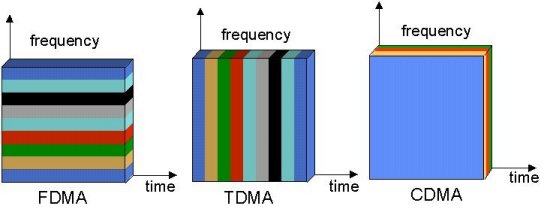
|
| Multiple Access Schemes |
CODING
CDMA uses unique spreading codes to spread the baseband data before transmission. The signal is transmitted in a channel, which is below noise level. The receiver then uses a correlator to despread the wanted signal, which is passed through a narrow bandpass filter. Unwanted signals will not be despread and will not pass through the filter. Codes take the form of a carefully designed one/zero sequence produced at a much higher rate than that of the baseband data. The rate of a spreading code is referred to as chip rate rather than bit rate.
See coding process page for more details.
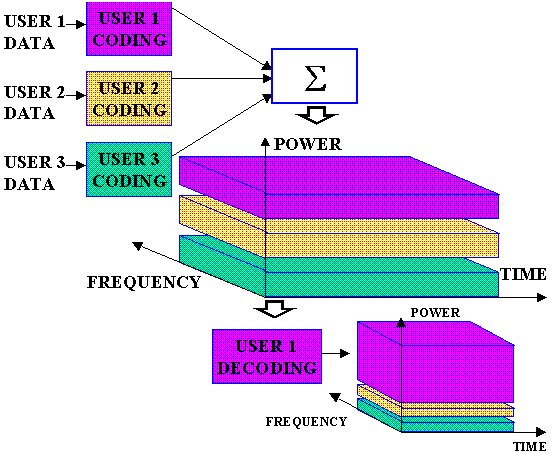
|
| CDMA spreading |
CODES
CDMA codes are not required to provide call security, but create a uniqueness to enable call identification. Codes should not correlate to other codes or time shifted version of itself. Spreading codes are noise like pseudo-random codes, channel codes are designed for maximum separation from each other and cell identification codes are balanced not to correlate to other codes of itself.
See codes page for more details.
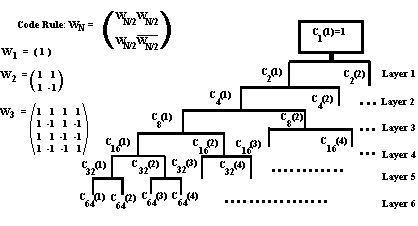
|
| Example OVSF codes, used in channel coding |
THE SPREADING PROCESS
WCDMA uses Direct Sequence spreading, where spreading process is done by directly combining the baseband information to high chip rate binary code. The Spreading Factor is the ratio of the chips (UMTS = 3.84Mchips/s) to baseband information rate. Spreading factors vary from 4 to 512 in FDD UMTS. Spreading process gain can in expressed in dBs (Spreading factor 128 = 21dB gain).
See spreading page for more details.
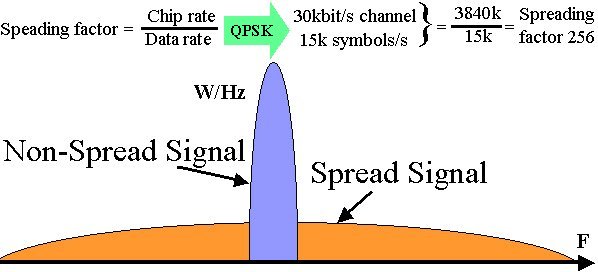
|
| CDMA spreading |
POWER CONTROL
CDMA is interference limited multiple access system. Because all users transmit on the same frequency, internal interference generated by the system is the most significant factor in determining system capacity and call quality. The transmit power for each user must be reduced to limit interference, however, the power should be enough to maintain the required Eb/No (signal to noise ratio) for a satisfactory call quality. Maximum capacity is achieved when Eb/No of every user is at the minimum level needed for the acceptable channel performance. As the MS moves around, the RF environment continuously changes due to fast and slow fading, external interference, shadowing , and other factors. The aim of the dynamic power control is to limit transmitted power on both the links while maintaining link quality under all conditions. Additional advantages are longer mobile battery life and longer life span of BTS power amplifiers
See UMTS power control page for more details.
HANDOVER
Handover occurs when a call has to be passed from one cell to another as the user moves between cells. In a traditional "hard" handover, the connection to the current cell is broken, and then the connection to the new cell is made. This is known as a "break-before-make" handover. Since all cells in CDMA use the same frequency, it is possible to make the connection to the new cell before leaving the current cell. This is known as a "make-before-break" or "soft" handover. Soft handovers require less power, which reduces interference and increases capacity. Mobile can be connected to more that two BTS the handover. "Softer" handover is a special case of soft handover where the radio links that are added and removed belong to the same Node B.
See Handover page for more details.
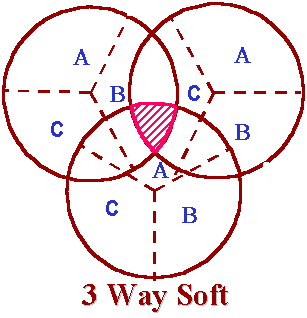
|
| CDMA soft handover |
MULTIPATH AND RAKE RECEIVERS
One of the main advantages of CDMA systems is the capability of using signals that arrive in the receivers with different time delays. This phenomenon is called multipath. FDMA and TDMA, which are narrow band systems, cannot discriminate between the multipath arrivals, and resort to equalization to mitigate the negative effects of multipath. Due to its wide bandwidth and rake receivers, CDMA uses the multipath signals and combines them to make an even stronger signal at the receivers. CDMA subscriber units use rake receivers. This is essentially a set of several receivers. One of the receivers (fingers) constantly searches for different multipaths and feeds the information to the other three fingers. Each finger then demodulates the signal corresponding to a strong multipath. The results are then combined together to make the signal stronger.




No comments:
Post a Comment